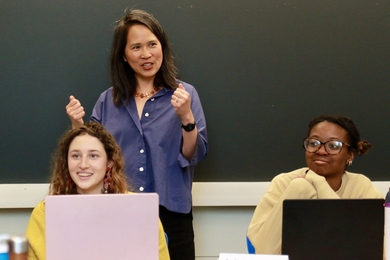Across Tanzania and elsewhere in Africa, processing the corn harvest is labor intensive: Families and friends gather to spend a day or two filling bags with the dried cobs, beating then to loosen the kernels, and then separating out the kernels from the cobs, or else simply removing the kernels by hand.
It would take one person about two weeks to complete the job alone, but thanks to a technology largely developed at MIT, there's a better, faster way.
Jodie Wu, an MIT senior in mechanical engineering, spent the summer traveling from village to village in Tanzania to introduce a new system for processing the corn: A simple attachment for a bicycle that makes it possible to remove the kernels quickly and efficiently using pedal power. The device makes processing up to 30 times faster and allows one person to complete the job alone in one day.
The basic concept for the maize-sheller was first developed in Guatemala by an NGO called MayaPedal, and then refined by Wu last semester as a class project in D-Lab: Design, a class taught by Department of Mechanical Engineering Senior Lecturer Amy Smith. Now, thanks to Wu's efforts, the technology is beginning to make its way around the world.
Wu developed the new version of the device after being inspired by the work of Bernard Kiwia, who teaches appropriate technology in Tanzania for an NGO called the Global Alliance for Africa. Kiwia visited MIT in the summer of 2007 for the first International Design and Development Summit and returned to Tanzania greatly inspired by the workshop, and immediately began producing a variety of devices to address local needs.
Among these were several bicycle-powered devices, including machine-shop tools like drills and bandsaws. A simple power-transfer system bolted onto the bicycle's frame allows the bicycle to be used normally for transportation, but then quicly converted by switching the chain so that it can be adapted for a variety of tasks -- making or repairing furniture, sharpening knives or processing corn. Thus, the owner of a bicycle, with a small extra investment, can travel from village to village to carry out a variety of useful tasks. A simple bike thereby becomes an ongoing source of income.
Wu refined the corn-sheller system, which was originally designed as a permanent installation that required a bicycle dedicated solely to that purpose, to make it an add-on, like Kiwia's tools, that could be easily bolted onto an ordinary bike and removed easily. She traveled through Tanzania this summer, thanks to a grant from the Baker Foundation through MIT's Public Service Center, to demonstrate how to build the corn sheller and how to use it, and to encourage local people to adopt the new technology. In order to make it possible for more people to buy the simple devices, she worked with a microloan program run by the Global Alliance for Africa.
Wu found the experience highly inspiring and was especially impressed with Kiwia's workshop in Arusha, where new devices are being spawned and tested constantly. "It was the first place where I had seen local technology created right there in the workshop," she says.
Wu had tested the earlier, permanently mounted version of the sheller in Tanzania in January but found that it had some technical issues and was too expensive for the local people to afford. The key to making it practical was to turn it into an add-on, something she accomplished during the spring semester D-Lab class. "That made it a mobile device, something that could be used as a service" by pedaling from one village to another, Wu says. And while this version was developed for Tanzania, she says, corn is grown widely in Africa and Latin America, and the simple bicycle-based technology is readily available in most developing countries, so the device could find widespread application.
"It was exciting to see my device, which I'd worked on with other students, being used by people who are now making money from it," she says. Wu hopes to further refine the design this fall, and plans to return to Tanzania to continue demonstrating its construction and use during next January's IAP.
A blog detailing Wu's experiences in Tanzania can be seen at tumainicycles.blogspot.com.
A version of this article appeared in MIT Tech Talk on October 1, 2008 (download PDF).






